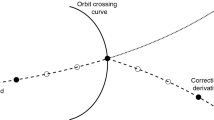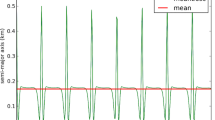Abstract
Mean orbital elements are obtained from osculating ones by removing the short periodic perturbations. Large catalogues of asteroid mean elements need to be computed, as a first step in the computation of proper elements, used to study asteroid families. The algorithms for this purpose available so far are only accurate to first order in the masses of the perturbing planet; the mean elements have satisfactory accuracy for most of the asteroid belt, but degraded accuracy in the neighbourhoods of the main mean motion resonances, especially the 2:1. We investigate a number of algorithms capable of improving this approximation; they belong to the two classes of Breiter-type methods and iterative methods. The former are obtained by applying some higher order numerical integration scheme, such as Runge–Kutta, to the differential equation whose solution is a transformation removing the fast angular variables from the equations; they can be used to compute a full second order theory, however, only if the full second order determining function is explicitly computed, and this is computationally too cumbersome for a complicated problem such as the N-body. The latter are fixed point iterative schemes, with the first order theory as an iteration step, used to compute the inverse map from mean to osculating elements; formally the method is first order, but because they implement a fixed frequency perturbation theory, they are more accurate than conventional single iteration methods; a similar method is already in use in our computation of proper from mean elements. Many of these methods are tested on a sample of asteroid orbits taken from the Themis family, up to the edge of the 2:1 resonance, and the dispersion of the values of the computed mean semimajor axis over 100 000 years is used as quality control. The results of these tests indicate that the iterative methods are superior, in this specific application, to the Breiter methods, in accuracy and reliability. This is understood as the result of the cancellations occurring between second order perturbation terms: the incomplete second order theory, resulting from the use of a Breiter method with the first order determining function only, can be less accurate than complete, fixed frequency theories of the first order. We have therefore computed new catalogues of asteroid mean and proper elements, incorporating an iterative algorithm in both steps (osculating to mean and mean to proper elements). This new data set, significantly more reliable even in the previously degraded regions of Themis and Cybele, is in the public domain.
Similar content being viewed by others
References
Arnold, V. I.: 1963, ‘Small denominators and problems of stability of motion in classical and celestial mechanics’, Russian Mathematical Surveys 18, 85–191.
Arnold, V. I.: 1976, Les Méthodes mathématiques de la mécanique classique, Éditions MIR, Moscou.
Breiter, S.: 1997a, ‘On the numerical transformation of variables in perturbation theory’, Celest. Mech. Dyn. Astron. 65, 345–354.
Breiter, S.: 1997b, ‘Second order solution for the zonal problem of satellite theory’, Celest. Mech. Dyn. Astron. 67, 237–249.
Butcher, J. C.: 1987, The Numerical Analysis of Ordinary Differential Equations, J Wiley.
Carpino, M., Milani, A. and Nobili, A. M.: 1987, ‘Long-term numerical integrations and synthetic theories for the motion of the outer planets’, Astron. Astrophys. 181, 182–194.
Cooper, G. J.: 1987, ‘Stability of Runge-Kutta methods for trajectory problems’, IMA J. Numer. Anal. 7, 1–13.
Danby, J. M. A.: 1988, Fundamentals of Celestial Mechanics, Willmann-Bell.
Hori, G.: 1966, ‘Theory of general perturbations with unspecified canonical variables’, Publ. Astron. Soc. Japan 18, 287–296.
Knežević, Z.: 1988, ‘Asteroid mean orbital elements’, Bull. Astron. Obs. Belgrade 139, 1–6.
Knežević, Z.: 1992, ‘Minor planet short-periodic perturbations: the indirect part of the disturbing function’, Celest. Mech. Dyn. Astron. 55, 387–404.
Message, P. J.: 1976, ‘Formal expressions for the motion of N planets in the plane, with the secular variations included, and an extension to Poisson's theorem’, in: Szebehely and Tapley (eds), Long-Time Predictions in Dynamics, Reidel, Dordrecht, Holland, pp. 279–293.
Milani, A.: 1988, ‘Secular perturbations of planetary orbits and their representation as series’, in: A. E. Roy, (ed), Long-term Dynamical Behaviour of Natural and Artificial N-Body Systems, Kluwer Academic Publishers, pp. 73–108.
Milani, A., and Knežević, Z.: 1990, ‘Secular perturbation theory and computation of asteroid proper elements’, Celest. Mech. Dyn. Astron. 49, 347–411 (Paper I).
Milani, A., and Knežević, Z.: 1992, ‘Asteroid proper elements and secular resonances’, Icarus 98, 211–232 (Paper II).
Milani, A. and Knežević, Z.: 1994, ‘Asteroid proper elements and the dynamical structure of the asteroid main belt’, Icarus 107, 219–254 (Paper III).
Milani, A. and Mazzini, G.: 1997, Sistemi dinamici, Pisa University Editorial Service.
Milani, A., Nobili, A. M. and Carpino, M.: 1987, ‘Secular variations of the semimajor axes: theory and experiments’, Astron. Astrophys. 172, 265–279.
Milani, A., Nobili, A. M. and Knežević, Z.: 1997, ‘Stable chaos in the asteroid belt’, Icarus 125, 13–31.
Morbidelli A., Zappalà, V., Moons, M., Cellino, A. and Gonczi, R.: 1995, ‘Asteroid families close to mean motion resonances: dynamical effects and physical implications’, Icarus 118, 132–154.
Poincaré, H.: 1893, Les Méthodes Nouvelles de la Mécanique Céleste, Vol. II, Gauthier-Villars; reprinted by Blanchard, Paris, 1987.
Sanz-Serna, J. M.: 1988, ‘Runge-Kutta schemes for Hamiltonian systems’, BIT 28, 877–883.
Yuasa, M.: 1973, ‘Theory of secular perturbations of asteroids including terms of higher order and higher degree’, Publ. Astron. Soc. Japan 25, 399–445.
Author information
Authors and Affiliations
Rights and permissions
About this article
Cite this article
Milani, A., Knežević, Z. Asteroid Mean Elements: Higher Order and Iterative Theories. Celestial Mechanics and Dynamical Astronomy 71, 55–78 (1998). https://doi.org/10.1023/A:1008315029975
Issue Date:
DOI: https://doi.org/10.1023/A:1008315029975




